I got the crazy idea to convert some Danish sea trout and salmon flies to intruders. It worked out surprisingly well.
Denmark has always been a country where you could hunt for large sea going brown trout when they returned to the stream to spawn. Most famous for this fishing is the Danish river Karup, but many other less renown streams and rivers have produced some amazing sea trout over the years.
During the last decade and then a bit, Danish rivers have also transformed into world class salmon rivers, thanks to a very targeted restoration effort and lots of work from organizations and local clubs – as well as the authorities.
Swinging large flies
So swinging large flies for large fish in slow and deep rivers, typically using two hand rods, has been a very common way of fishing running water here.
That has of course led to the development of a bunch of local sea trout and salmon flies, which have been selected and refined by anglers over the years and produced many magnificent fish.
Many have been tied on traditional salmon hooks, and quite a few either originated as, or have been transformed to, tube flies, a very popular and common type of fly here.
But you rarely see an intruder mounted on a Danish salmon or sea trout rod, which I think is too bad.
Martin Joergensen
Waddingtons and tubes
Waddington shanks are seen now and then, and are by far more common than intruders, but both are vastly outnumbered by tubes, which is the most popular style when a bit of size is needed.
I like intruders and I'm sure they will work just as well as many of the tube flies, not least because of the added weight. Sure enough, Danish streams are often slow flowing, and getting a tube down isn't hard, particularly if it has been tied with one or more cones, but Danish streams can also be deep, and a heavy fly can be the key to success. There are limits, and the largest and heaviest intruders, designed for Pacific salmon in high octane rivers with brutal current, will probably just lead to dredging and constant snags.
Something in between should fare well.
Not quite as light as a plastic tube, but not made with an extremely heavy wire shank and lead dumbbell eyes either.
Light shanks
Luckily there are bunches of light shanks around. Thanks to the increasing popularity of articulated flies, it's possible to get you hands on some shanks, which aren't quite as frightful as the humongous and heavy ones used for flies for king salmon in ultra fast BC rivers. Shorter shanks, thinner wire and even lighter materials, like aluminum rather than steel.
By using shanks of a less hefty character, it's possible to tie flies, which are manageable on lighter rods, but still heavy enough to get down to the fish. Using a sinking leader or even a sinking line can of course speed up the process, but again might mean snagging quite a bit.
Another thing I like about the intruders is the fact that they are tied with single hooks. Most tube flies are equipped with trebles or doubles, and honestly don't look too good with singles, but if you, like me, like to fish with singles and even barbless hooks, intruders can be a good option. The disadvantage can be less flexibility, because even though hooks can be changed on some intruders, not all have large enough wire loops to allow for removing a dull or bent hook hook and mounting a new one.
Rounding off
Many of the flies I have chosen to convert are originally tied with an orientation – a top and a bottom. Intruders on the other hand are often tied "in the round", symmetrical around the shank
When flies with a wing and a keel are tied round, they do kind of loose their kinship to the original fly, and tend to preserve colors alone. Still, I have tried rounding some of the flies.
It's also common that the original flies have tails, but again the intruders are often better with symmetry, and a rear hackle in the original's tail color is much more "intruderish" than a small tail.
What I used
While working on flies for this article I have used shanks from several manufacturers including Danish Futurefly, Canadian Tube Fly Company, German Würtz and the US companies Flymen Fishing Company and OPST. I used wire from Danish Skagit Anglers and UK company Partridge and hooks from several sources including Danish Ahrex, UK Partridge and Norwegian Mustad.
The flies shown on this page all use the same combination of hook and shank, namely the Ahrex HR483 barbless Trailer Hook in a size 2 behind a Futurefly 35 mm shank. The connection is a fairly thin wire in the 20-40 lbs range, the colored ones from Danish Skagit Angler.
A handful
I have taken a handful of river patterns that I really like and transformed them into intruders. These are commonly tied on salmon hooks, a few originated on tubes, but all are quite well suited for an intruder makeover if you ask me.
You can see a full step-by-step under the Wet hen below, which servers as a general template for all these intruder conversions.
The Idiot
I always liked the Idiot. Both the fly and the Iggy Pop album. But since this is fly fishing, I'll stay with the fly pattern here. The fly reminds me a bit of Bloody Butcher. The combination of red and black and something shiny is a killer. The Butcher features silver, the Idiot gold. Also the Idiot is perfect for my conversion since it has no wing, but just hackles. Transforming the tail into a hackle too made it a perfect Intruder, and this is definitely a fly that will work like a charm on almost any river. The story about the original pattern has been told here before, and I refer to that article for more information.
The Niner
In Danish it's called Nieren or 9'eren as in the number nine, allegedly so named because the first fish caught on the fly was a 9 kilo sea trout. It's quite a popular fly here, and owes its existence to Alf Petersen, AKA Natmanden or The Night Man, an angler known from the River Karup. As Petersen's nickname indicates, he favored fishing in the dark hours, and this fly was designed to be good for night fishing. Its large black wing is a hallmark of night flies, but the contrasting white and orange helps to let it be seen in peaty water or against the banks of the dark river.
This fly was tied on a tube and typically fished high in the water, but tying it on a shank might not be such a bad idea, since its colors, black, orange and white, will set it apart from its surroundings, even when fished deep. Many tyers including the originator have also added weight to the tube version in the form of some heavy wire under the body.
The Tropical Sparrow
This is a much loved Danish sea trout fly, which was originated by Jens Hvam from Hagebro on the brinks of the famous Danish river Karup. The fly has taken many a large fish in this river and others, and is often lauded for its weight, which it owes to the copper body and originally being tied on a Waddington shank, both adding greatly to the mass of the fly.
Converting this to an intruder is a very short step, and won't bring it far away from the original. I have chosen to replace the original orange body hackle with two separate hackles, one in the rear and one in the front. I have also replaced the original badger hair underwing with one of dark bucktail, as well as using Artic fox for the throat in favor of back bear as originally prescribed. The difference is hardly noticeable. On the original, seen in the beginning of this article, the hook connection was covered by orange tubing, but I typically omit such tubing on all my intruders, and this fly has plenty of orange as it is.
You can of course equip this fly with eyes like the rest of the patterns mentioned here, but that will make it very heavy.
The Wet Hen
The Wet Hen is a sea trout fly originated by the Gels River in southern Denmark, and traditionally tied on a salmon hook. I have seen this fly converted to a tube fly on several occasions, but like the other flies here, a Wet Hen intruder isn't a common sight.
The original Hen uses teal as a front hackle, but it's not always easy to get in large sizes, so mallard flank can do as a stand-in with slightly less contrast. Also, the tag on the original is tied in after the tail, as a kind of rear body. I have opted to tie both versions: one where I follow the original, and one with the tag as it's traditionally done on salmon flies, under the tail. You can clearly see the original style in the photo in the beginning of the article. As with the other intruders you can put eyes on the Wet Hen to get a heavier fly.
Tying instructions
This step-by-step servers as a general template for tying an intruder. The essence is to attach and secure the trailing hook to the shank in the proper position and distance, and then tie the fly on the shank. Click on each picture for a larger version and detailed instructions. Use your arrow keys to navigate to the next and previous step.
|
|
|
|
|
|
|
|
|
|
|
|
|
|
|
|
|
|
|
|
|
|
|
|
|
|
|
|
|
|
|
|
|
|
|
|
|
|
|
|
Red Tag
I have fished the Red Tag for many years as a sea trout fly for sea run browns, and it has also been used for sea trout and even salmon in the rivers. Hailing from 1850 and originally tied as a grayling dry fly, it has indeed gone through a major metamorphosis.
From a dry fly tied on small hooks in the 16-12 range, then transforming into a wet fly tied on slightly larger hooks in the 10-4 range, then tied on salmon hooks up to 2 and 1 even larger, probably adapted for a tube somewhere further underway, and now I take it one more step and tie it on a shank with a trailing hook.
There's a reason why this fly has been used in so many shapes: it's a really good fly! A small red tail, a ribbed peacock herl body and a brown front hackle. It's simply a great combination of materials and colors. And it is a classic. It even has an entry in Wikipedia.
Like many of the other patterns here, I have tied in two hackles: one in front and one in the rear. I could have palmered a hackle, but I honestly think this looks better and it's also more durable.
Mörrum Fly
Danish Jan Grünwald's Spey style fly has been a popular fly, both in its "home river", the Swedish Mörrum, and in many Danish rivers since its appearance in the late 80's and early 90's. It's a classic feather winged Spey fly, utilizing long golden pheasant body feathers as a Spey hackle, and the tail feather from the same bird as a wing, straddling a small bunch of GP tippet.
The conversion led to rounding the fly as mentioned above, and the red wool tag was replaced by a red hackle while the wing was converted to a ring of loose tail barbs, tied in the style often seen done on intruders using loose, dyed Amherst tail feather barbs.
The tippet could have been tied in round too, but was kept as a small wing, adding an accent of color between the hackles.
There's a whole article on The Mörrum Fly here.
- Log in to post comments



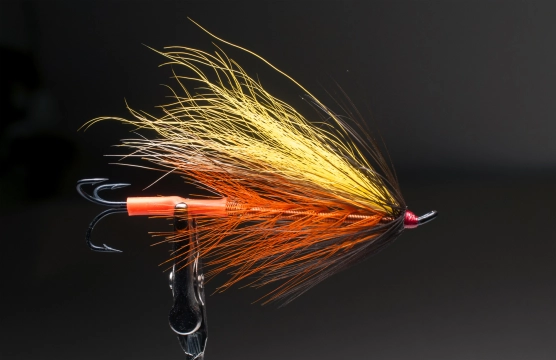





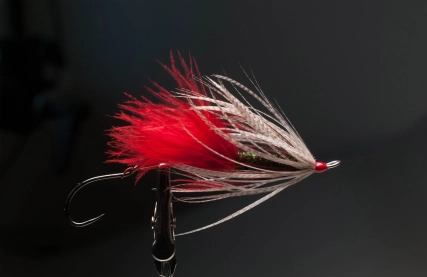



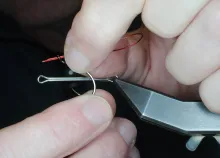

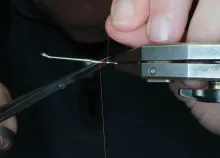










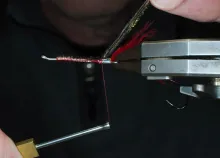






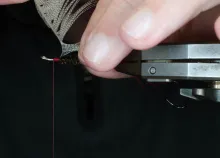




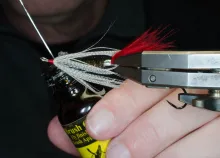





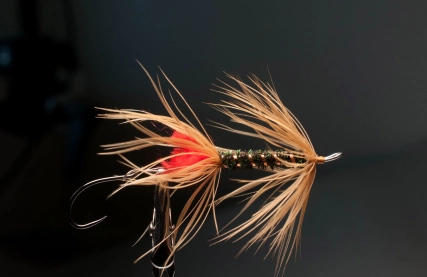









Intruders
What an interesting article - not a crazy idea at all. I have also made a couple of intruders for the coming sea-trout season, but I will also make a couple of your conversions. The Wet hen intruder I am sure will do great.